30+ Pertinent Marketing Questions Answered by Industry Experts During #GROWTHAsia 2020
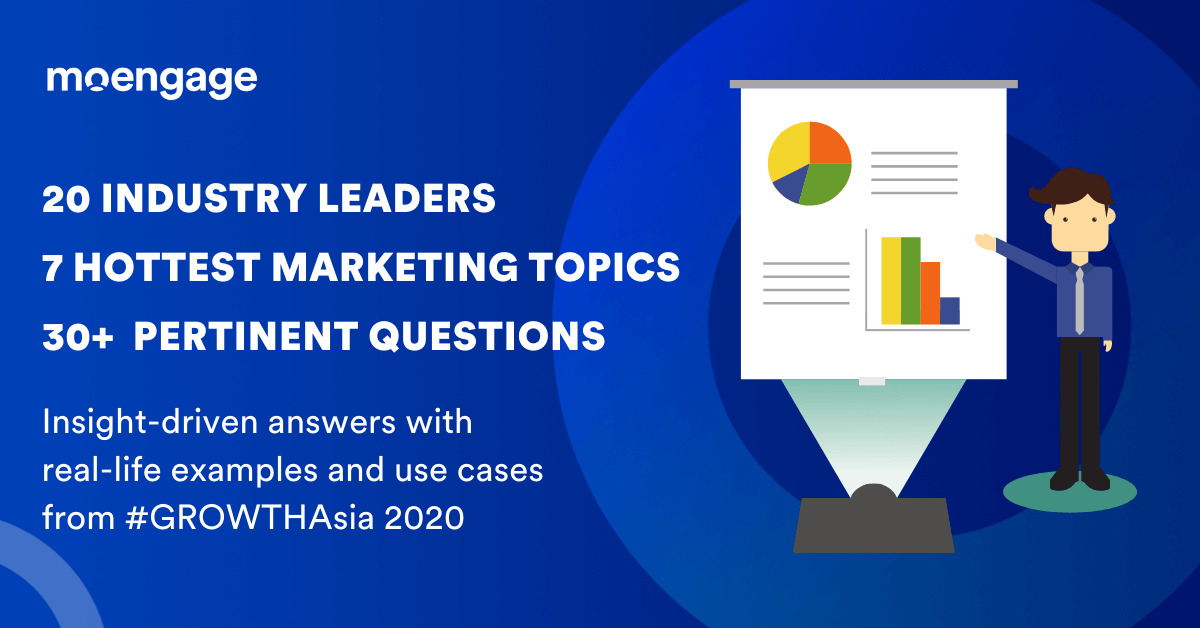
Reading Time: 18 minutes
We concluded a two-day virtual summit, #GROWTHAsia 2020, which aimed to provide the community of growth marketers and product owners clarity about the most discussed marketing topics of 2020.
We assembled 20 marketing experts from the top and notable brands in Asia like Airtel, OYO, ONE Championship, Tokopedia, Zilingo, OLX, Zee5, and MX Player, among others. The panels and growth sessions were moderated and led by experts from MoEngage and our event partners: Mixpanel, Branch, and Segment.
Before you dive into the details check our Global Mobile Consumer Trends report 2020 to evaluate your mobile app’s performance against the industry benchmarks right here!
Without further ado, here are the seven topics that the marketing leaders discussed and shared their insights on:
- Marketing During COVID-19: The impact of the global health crisis on business and how it has shaped the Marketing approach in the post-crisis world.
- Product-Marketing Alignment For Better CX: Discussion on the importance of mutual functioning between engineering, product, and marketing teams focusing on efficient sprint cycles driven by agile ideation and go-to-market strategy.
- Efficient Customer Onboarding: The role of a consistent experience across various channels on user retention and the approach employed by customer-obsessed brands.
- Crafting Brilliant Omnichannel Experience: Understanding the importance of a 360-degree customer view creates an engagement framework from acquisition to retention across the customer journey.
- Optimizing and Maximizing Mobile Push Delivery: Discussion on improving customer engagement by optimizing push notification as a channel and factors affecting push notification delivery rates and how to solve for them.
- Effectively Scaling Personalization Across Customer Journey: Improving the UX through personalization by understanding attributes such as user behavior, purchase history, spending pattern, and more using analytics.
- Building Modern Growth Stack: Unpacking complexities of modern growth stack, tools, and resources required to build it, UX use cases it can resolve, and how it can be implemented to overcome challenges in the mobile-first world.
Each of the expert panels was accompanied by a detailed Q&A section, where the panelists answered the audience questions related to the topic at hand. Some of these questions happened to be the most frequently asked on the said topic. So, we decided to bring you this article to consolidate some of the most pertinent questions that will resonate with anyone in today’s marketing scene.
Bonus Content
|
Moving on, you will find the seven broad topics covered in the expert panels, along with the questions and answers. Happy reading and we hope this helps in providing you perspective and insights.
If you have more questions regarding these topics, feel free to write to us at [email protected].
Marketing During COVID-19
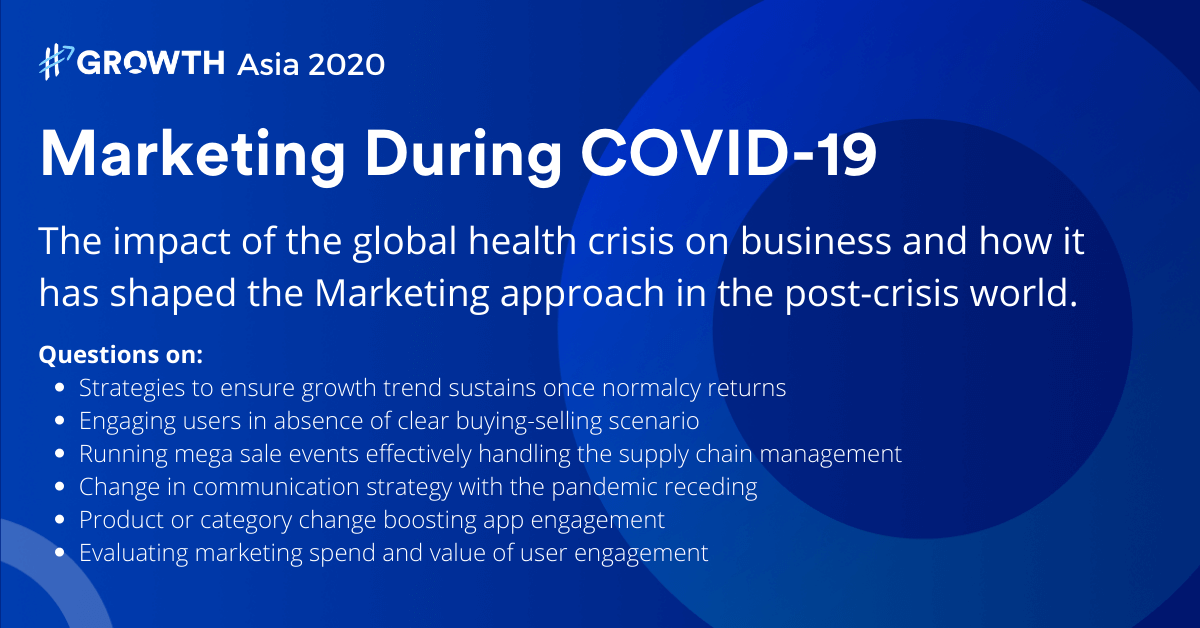
Experts:
- Sapna Arora, CMO, OLX
- Abhishek Joshi, Head of Marketing, MX Player
- Harish Narayanan, CMO, Myntra
- Anugrah Honesty, Senior Digital Marketing Manager, Bukalapak
- Ashwin SL, VP Marketing, MoEngage
- Brands in the media and entertainment space have seen an enormous growth spike during the pandemic, which can be attributed to the increased interest during the mandatory lockdown period. Beyond the pandemic, what are the strategies to ensure that the growth trend (increase download and DAU) is sustained?
Most apps in the OTT/media and entertainment ecosystem have reported a significant increase in usage during the pandemic. It is, therefore, imperative to work on strategies to ensure that growth is sustained. While refreshing the content library by adding quality content is an option, the broader focus should be on meeting the user’s entertainment needs and not just video or music. One of the use cases from the Indian entertainment super app, MX Player, backs this up. The brand built a gaming ecosystem inside its app, which now hosts about 200 games. This strategy seems to have paid in dividends, mainly because they could cater to entertainment needs beyond just video consumption. The key here is diversifying to meet the user’s overall entertainment needs, which will ensure that even if one of your offerings takes a hit, the other popular avenue balances out the overall impact and sustains growth.
- During the peak of a pandemic, how does a brand which operates in the e-commerce space engage users in the absence of an exact buying-selling scenario?
There is no doubt that engaging a user during a crisis like COVID-19, especially for non-essential services, is difficult. However, the e-commerce segment is full of examples of brands nailing user engagement. One of the brands that have increased their user engagement despite the restriction on non-essentials is an Indian online fashion marketplace, called Myntra. The brand decided to focus on helping users relieve stress by offering a platform where they can come and browse various work-from-home wardrobe choices and fashionable collections. They organized online fashion masterclasses hosted by experts and created a fashion-content-focused platform called ‘Myntra Studio’ inside their app. The brand doubled down on the work-from-home lifestyle by starting a conversation on exercising, grooming, and styling tips to engage the user.
- During the COVID-19 crisis, how does an e-commerce brand run a countrywide sale effectively handling the supply chain management?
One of the most surprising use cases comes from Myntra, who decided to run with their biannual End Of Reason Sale (EORS) scheduled for June instead of postponing it. They could pull off the mega event through outstanding initiatives to keep the supply chain well-oiled and ready for sale. The brand prioritized employee health and safety, ensuring all health protocols were followed in warehouses, including social distancing and providing COVID insurance. Myntra increased efficiency measures by automating processes wherever possible. The online fashion retailer scaled last-mile delivery through Myntra Extended Network Through Store Activation (MENSA) using Kirana stores (local grocery stores). - What is the logic behind a brand like Myntra going ahead with a mega sale like EORS in June, post the unlock when regular business resumed with the expectation of organic traffic, after a period of sale restriction?
While it might seem so in hindsight, organic demand’s expectation was not a given at the sale time. Users were going through economic uncertainty and were still prioritizing essential spending. With organic traffic bounce back unproven, and as industry leaders, the brand had to lead the way to bring back customers in the fashion retail ecosystem. Furthermore, the sale was also essential from a business perspective in terms of reducing stock. - With the pandemic perceivably receding and businesses returning to a semblance of normalcy, how has the communication strategy particularly for e-commerce brands? Is it still about being helping the user deal with the crisis, or is it more sale-focused?
While the broader focus will still be on helping users, the way it’ll be communicated will differ. The brands will now focus on helping the users through their offerings. For instance, an online fashion marketplace like Myntra will communicate how it can help users refresh their everyday wardrobe, adding a dash of color to their life. The change in communication is backed by user behavior research done to understand usage, attitudes, current sentiments, barriers, better performing categories. Further deep dive into the revenue metrics revealed categories predicted to perform better and products likely to be purchased most. Based on this data analysis, the businesses now know what kind of messaging the consumer is more receptive to and which categories (products) they’re most likely to buy, thus building the new communication strategy. - Is there any instance of product change boosting app engagement as far as an e-commerce marketplace is concerned?
During the pandemic, many businesses, primarily in the e-commerce space were looking for ways to engage users in the absence of the usual selling scenario. Several businesses’ offline aspects took a massive hit with the lockdown restriction in place and hesitation from users to step out. Some brands worked on business continuity plans by introducing a new category wherein the user doesn’t need to step out. One of OLX’s use cases, a pre-owned goods marketplace, was to provide home inspection not to have to visit their physical stores for transaction needs.Bukalapak, Indonesia’s largest e-commerce company, realized that users need to stay updated with the latest development. They partnered with a news media company and included a section in their app dedicated to information about the health crisis, recent announcements, and government policies. This approach fed user curiosity and kept them engaged. The Indonesian e-commerce brand also worked with several vendors to create a live streaming shopping service (similar to TV shopping but on the app) of products like clothing, home essentials, etc. to keep the user engaged. - At a time when revenues for most businesses have taken a massive hit, and there is little indication of long-term growth, how do you evaluate the value of user engagement? How do you justify marketing spend and development time to drive engagement that may not directly translate to revenue?
While it is true that businesses across most verticals and geographies, bar a few have taken a big hit to their bottom line. However, it is not wise to tighten the purse strings without assessing your particular industry’s scenario. Suppose your brand has the majority of the share of voice for your industry. In that case, it is time to wisely spend on getting new customers when acquisition cost is low due to your competitors’ inability to spend. However, wise spending is the keyword here. When it comes to user engagement, it is of the utmost importance to retain users, which is the priority for any business. User engagement might not directly translate to revenue immediately but will benefit your business in the long run. The key is to optimize for Customer Lifetime Value with the right metrics in place, indicating the engagement metrics that will translate into long-term business gain.
Product Market Fit For Better CX
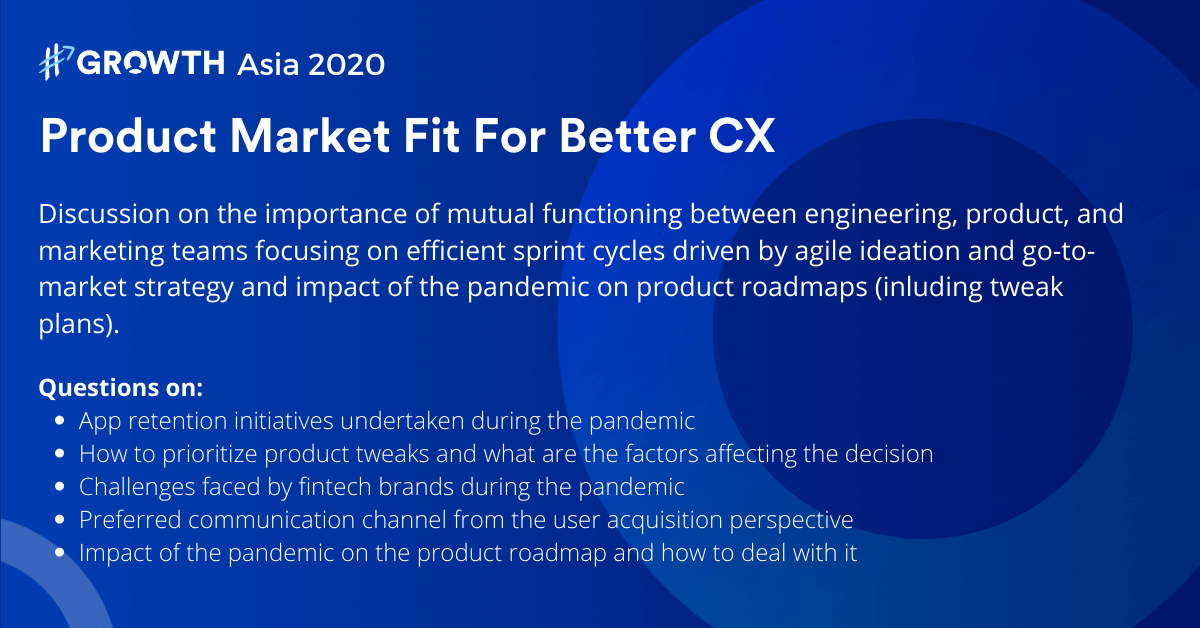
Experts:
- Kushal Manupati, Head of Digital, Zilingo
- Aditya Chintawar, VP Product Management, KoinWorks
- Ameya Sawant, Head of Growth, One Championship
- Scott Pugh, APAC Director, Mixpanel
- For a sports media brand like ONE Championship, how do you ensure app retention and what initiatives were taken?
During the COVID-19 crisis, with lockdown protocols in place and sports events being postponed, a martial arts sports media property like ONE Championship had to leverage their existing content to engage audiences. One of the biggest drivers of app retention happens to be their fantasy game called ONE Fantasy, which is available on their ONE Super App. The fantasy game is operational between live events and keeps users engaged in the absence of active bouts. - How did you prioritize product tweaks for a sports media property like ONE Championship, and what can brands learn from it?
Product tweaks at ONE Championship are driven by user feedback. The brand runs polls on their app to understand what users want from the platform, and based on that, they change their approach, which initially began as a platform to help users consume the best martial arts related content. The key takeaway is to respect the user needs and deep dive (data-backed) into the user psyche to understand what exactly solves the pain point(s). - As a brand in the peer to peer lending space, what are the challenges you had to face, and what’s the preferred communication channel from a user acquisition perspective during COVID-19?
The challenges in the initial days of the pandemic were to identify the marketing channels that would work. The key was retention-first and gradually reactive earlier users. Another major issue that needed fixing was data visualization. What worked for us was running surveys and Focus Group Discussions with experts from around SEA and India to get a directional sense of what’s going to work and what isn’t. The one communication channel that saw the least drop in open rates was email, even when compared to push notification. The initial emails that we sent out, which dealt with COVID-19 and its impact on the lending ecosystem, caught the user’s attention, which we leveraged in our following email campaigns. - How will the pandemic affect long term product roadmap and plan?
With the pandemic affecting user behavior in multiple ways and in fact, permanently shifting user interaction, the product road will definitely be impacted. Industries might need to look at digital transformation if they already haven’t, with increasing user hesitation towards offline business. Some businesses might have to assess their subcategories and if found popular might have to adapt the roadmap to focus accordingly. To top it off, the business recovery models, lack of revenue, and resources to spend on development might have a significant impact on the already planned product roadmap. - How does one deal with the effect of the pandemic on the product roadmap planning?
The best way to deal with the situation is to have more than one roadmap option in the store. The ideal way is to build at least three roadmap options handy and execute them depending on how the user behavior and interaction patterns change.
Efficient Customer Onboarding
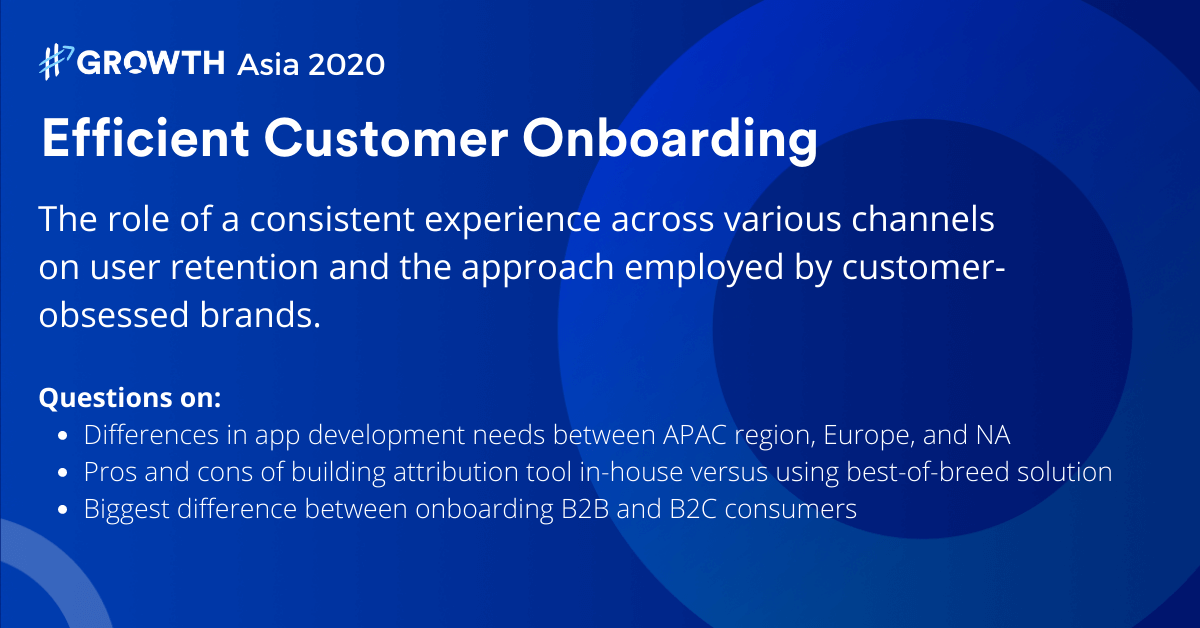
Expert: Govind Kavaturi, Director of Partnerships, Branch
- What are some of the significant differences between APAC countries like India vs. a country in Europe regarding limitations for the app developers to deliver user experiences?
Broadly there are two categories of markets: mobile-first and desktop-first. In desktop-first markets like Australia, the USA, some parts of Europe (UK and Germany), experiences and flexibility are critical. This is primarily because of more platforms involved and users predominantly operating on desktop or mobile web. Hence, the need to create experiences to cater to them. In the APAC region, except Singapore, Australia, and to an extent, Thailand and India, the rest of the areas are mobile-first. The challenges with a mobile-first approach are on the onboarding side, viz. within 24 hours of installing an app, what does the user see on the app. This a more significant challenge for mobile-first markets compared to the flexibility of getting onto the mobile app. - What is your opinion on building attribution technology in-house versus using already built tools?
While product teams have been figuring out mobile experiences for years now, with some companies investing millions of dollars into deep linking technology, it is almost impossible to build that kind of technology in-house. The reason being it is not possible to build a network with just a single company. When you’re building links, your users are within just your platform, but what a third-party platform like Branch allows interactions with tens of thousands of companies, thereby creating better accuracy. - What is the biggest difference or challenge between onboarding B2B vs. B2C customers?
With B2B customers, you have more data available, enabling you to build experiences. In contrast, with consumer brands, there’s a shortage of data, with marketers having to predict a lot of the times. Another challenge with B2C companies is that millions of users whose experiences need to be personalized at scale, compared to say something like 50,000 odd customers on the B2B side.
Crafting Brilliant Omnichannel Experience
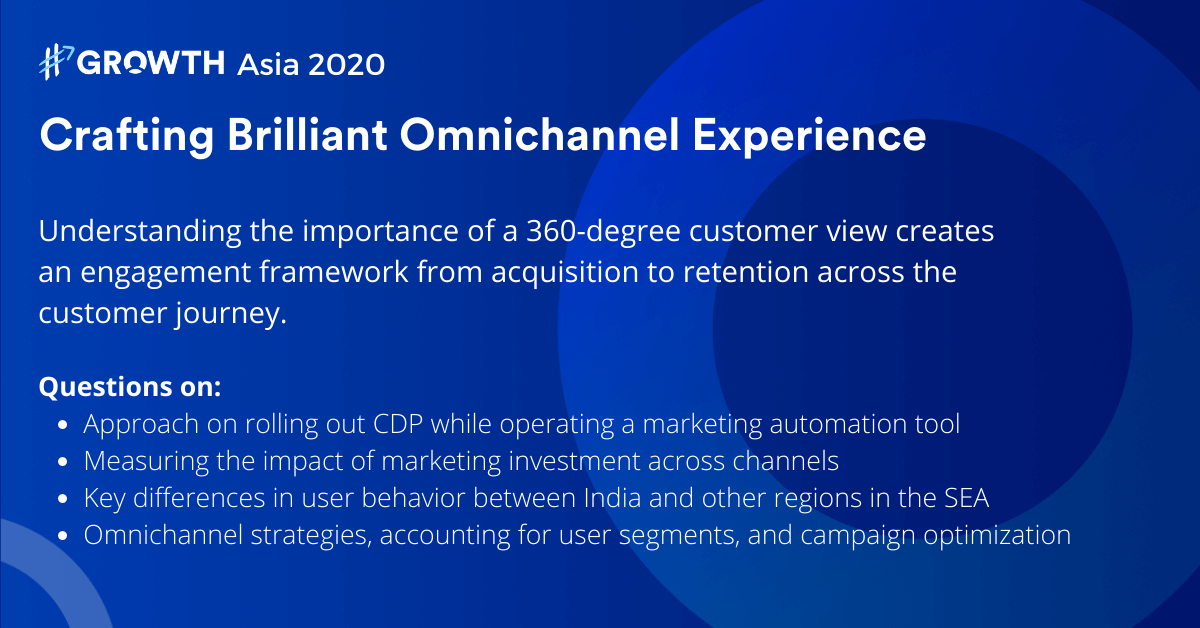
Experts:
- Paul Bantayan, Head of Marketing, Cashalo
- Mahendra Dhiraj, Head of Business Analytics and Consulting, PT GTech Digital Asia
- Vani Dixit, Head of Customer Management, ZEE5
- Rajan Bansal, Head of Growth Marketing, Airtel
- Brajesh Rawat, Ecommerce Head, Marks & Spencer
- Kunal Sharma, Senior Director of Growth (India), MoEngage
- Doesn’t CDP take significant time to build, and can a brand afford to have that as an ongoing activity and operate a marketing automation tool? How to deal with that?
CDP rollout is indeed complex depending on the dynamics and the platforms and applications in place. There are multiple tools, both open source and paid, that can help you to roll it out faster. Marketing automation tools can run in parallel to the same; in fact, to an extent, the marketing automation tool would cater to your requirements, e.g., when you have a single sign-on across all platforms with a unique ID. - How do you measure the impact of marketing investments across channels and then decide where you should be investing more?
Every channel of marketing investment has its own metrics, for example, a video ad should not be measured by conversion with a purchase rather as an attribution model path to conversion with brand awareness. Analyze your marketing spend with an attribution model than the last click to optimize your spending; you might have to play around with the model to get it right. Also, it can keep evolving, so you’ll have to monitor it as well based on the type of campaign and product. - What are some key differences in terms of customer beliefs and values across different category businesses in Indonesia and India?
To comment on sports and fashion, the spending pattern is a lot different between the markets. eg customers in Indonesia are strongly engaged in social channels, Key Opinion Leaders (influencers) compared to India. Additionally, gamification works extremely well in the Indonesian market vis a vis the Indian market. - In relation to omnichannel engagement, the fintech industry is heavily pushing app-based interaction. However, there are still some user segments that get acquainted with the brand via the website. How does the omnichannel strategy being implemented by a fintech brand like Cashalo, take such user segment into consideration to ensure no lost opportunity?
There are users who will visit first the website before downloading the app. For Fintech services, it’s best to really make the experience across any channel, whether it’s a website or even a salesperson on the ground because that salesperson is also a channel in itself – to make the experience seamless, unified, and consistent. So, for the role of the website itself, we need to make sure the customer finds anything and everything they’re looking for, which would eventually lead them to download the app because that’s essentially where the relationship goes to the next level. - What strategies can be undertaken for using omnichannel campaigns to boost repayments for a lending app?
It’s really a collaboration between the Collections Team and the Marketing team because if you’re in the lending business, more than half is a collections business. Both of these teams must be able to leverage the data that you have on the customer i.e. did he/she pay back using a particular app or channel before, where does he/she live, and in the location where he/she lives, what are the best available channels for repayment? Post all these considerations, content, and channel strategy can be crafted around the audience data. - Is it wise to segment a user base as low as 10,000 active users (based on their language or genre preference) when there is a limitation on the content available on a platform compared to other leading OTT players in the industry?
Yes, it is absolutely essential to segment users based on the preferred genres and language even if the user base is currently small in size viz. 10K active users. As your user base grows over time, it will provide you the opportunity to accurately target users by marrying their preferences with the available content on your platform. In case you didn’t segment users in the starting, it’ll cause trouble for you further down the line. - What do you suggest OTT platforms should do to retain the incremental DAU observed on the platform during the lockdown period?
There are two types of users we noticed during this period on Zee5: ones who seemed to like the content on display later turning into loyalists and others who came to the platform for specific content and aren’t too keen on returning. The brand is building the content pipeline to engage and bring back such users. The OTT platform marketing has been going strong. These OTT platforms have been releasing movies during the lockdown and analyzing the audience’s reaction by creating taste clusters. Marrying the taste clusters with the content library to understand if the brand has enough to talk about what users like is the key here. The rest of the work is on creating differing communication strategies to reach out to the users. - The pandemic has adversely affected the fashion brands as people are prioritizing essentials spends in favor of luxury. How does a retail brand like Marks & Spencer engage end-users and at the same time drive transactions? Have any changes been made in the marketing strategy and how does an omnichannel strategy help the business?
It is no surprise that a category like fashion retail isn’t a priority in times when customers prefer essential spend like grocery. While certain categories like formal wear and tailored clothing have taken a hit with people working from home, others like lingerie, casual/loungewear, and kids wear have shown growth spikes. Going forward, Marks & Spencer will continue tweaking offerings in alignment with the traction observed. Being a global brand, Marks & Spencer had a good share of learning from countries around the globe which helped them prepare better for India as a region.
Optimizing and Maximizing Mobile Push Delivery
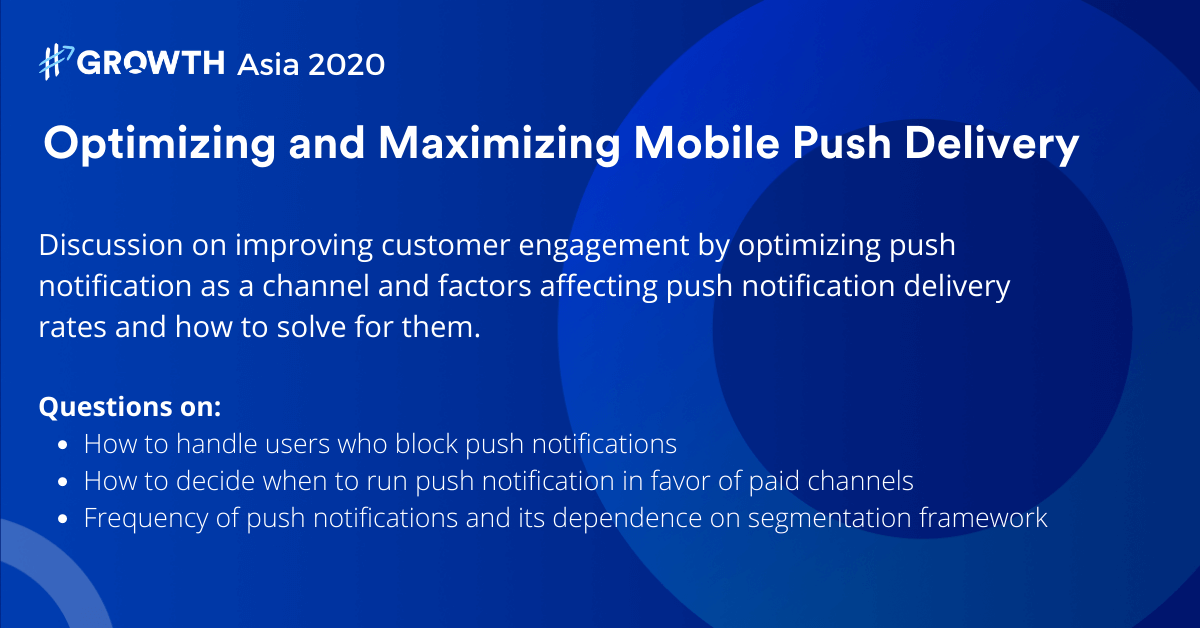
Experts:
- Arjya Nathvani, Head of Growth Marketing, OYO International
- Nalin Goel, VP Product, MoEngage
- Shivangi Bhogani, Director of Growth, India, MoEngage
- If we have most of our focus on Push, how do we tackle a growing number of customers who are blocking notifications in their handsets?
It can be solved through product interventions by giving the users an option to choose the kind of communication they want and the channel they want it on. For instance, if the users want only sale-driven communication via push or emailers, that is what needs to be sent. By providing this choice, the users are more likely to be receptive rather than block notifications due to irrelevance in marketing communication. - How do you decide if you want to run re-engagement campaigns targeting the existing users through paid networks vs the same audience you may want to target through Push considering it is a much cheaper channel? Or are these independent decisions?
Absolutely not independent decisions. The first step to evaluate which channel to use is to understand the segment of users for whom the app is still installed and the push token is active. Based on this observation, coupled with insights from the segmentation framework (i.e. who is a higher value customer and who is not), the willingness to spend will differ. So, basically it is understanding the reachability of push and the consideration of cost incurred through a new channel that decides the approach. Most use cases dictate sending push notifications to retarget users by analyzing customer journey (through MoEngage Flows) and for the audience who can’t be reached (either due to reachability or deliverability) are sent emails, SMS before proceeding with paid channels. - What are your thoughts on the frequency of push notifications sent to users? OYO seems to aggressively send push notifications. Don’t you think this irritates users?
The frequency of push notifications at OYO is determined by the segmentation framework. The user segments who are most active tend to receive more notifications and those inactive don’t receive as much. Similarly the more a user engages with the app, the more he/she sees the notifications and alerts, as the targeting models get triggered accordingly.
Effectively Scaling Personalization Across Customer Journey
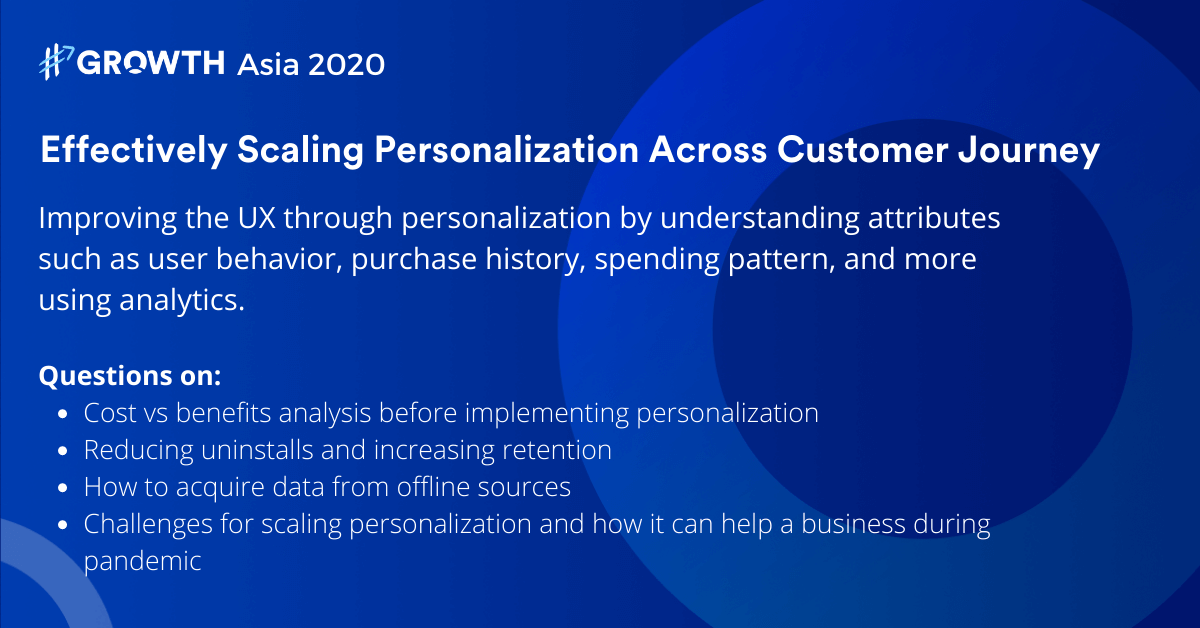
Experts:
- Olivia Kurniawati, Head of Product Marketing, Tokopedia
- Jenna Kosasih, CCO, PT GTech Digital Asia
- Agnes Lie, Head of Growth Marketing, Ovo
- Christina Lee, Senior Director of Client Success, Verticurl
- Divya Jagwani, Growth Manager (SEA), MoEngage
- How do you measure the cost vs benefits before implementing complicated solutions to personalization? Because the data needed for personalization would be massive.
The amount of data needed to understand the consumer behavior and thereby personalize the experience is indeed massive which makes it all the more important to prioritize which data suits you best for your goal whether it’s a long term or short term one. There are few approaches to determine data priority viz. observing the ROI or most upliftment given by the product marketing in specific lead time. - I’m running campaigns on Facebook and Google with good install rate but equally high uninstalls and low retention rates. What can I do to reduce uninstalls and increase retention?
Once the user data is being tracked, observe the activity done by the user upon landing on the app or the website to understand the behavior. Followed by this, it is important to notice the funnel to understand if the user is completing any other activity or dropping off, to analyze the steps in the user journey. This exercise will give you an idea into why and where the user is dropping off, which you can then work on to reduce uninstall rates and optimize retention. - How can you acquire data from offline sources (like brick & mortar stores) and link it to user behavior in order to plan for a personalized experience?
There are several ways one can go about collecting and collating data to analyze user behavior and later leverage it to provide a personalized experience. Here are some of the most common sources:
– Offline sales database
– Customer data on brand loyalty platform
– Technology-driven approaches like geofencing, RFID or data collection system during the offline interactive media within the offline space. - What are some of the mistakes you have seen marketers do while attempting to personalize user experience?
There are three main challenges that come with scaling personalization: data collection, data activation, organizational alignment across all functional teams. While data collection on the surface seems pretty straight forward, it is important to note what kind of data you collect, how you collect it, and store it. The main challenge with data activation is figuring out the tools that enable you to scale and utilize the data collected in a meaningful way. The final challenge is of the people or the talent driving the whole personalization effort, they need to be well versed with the technology to optimize, automate, and drive meaningful conversations. The various teams involved in the effort need to be on the same page in terms of data being collected and analyzed. Brands need to unite all the functional teams and align them to a singular goal of collating and analyzing data to drive personalization at scale. - As a brand in the fashion and lifestyle industry, how has the pandemic changed the business approach, and how does personalization help user engagement during this period?
During the COVID-19 pandemic, a lot of companies have shifted their business online, even brands who previously didn’t have an online presence or weren’t interested. This in turn has created even tougher competition amongst similar platforms. The only way to differentiate is by providing a seamless customer experience. That is precisely what personalization aims to offer, an efficient, faster, and easier journey for customers whether it is to find products they need or are interested in, based on their digital path. This helps brands overcome competition and convert users without relying solely on promotion events.
Building Modern Growth Stack
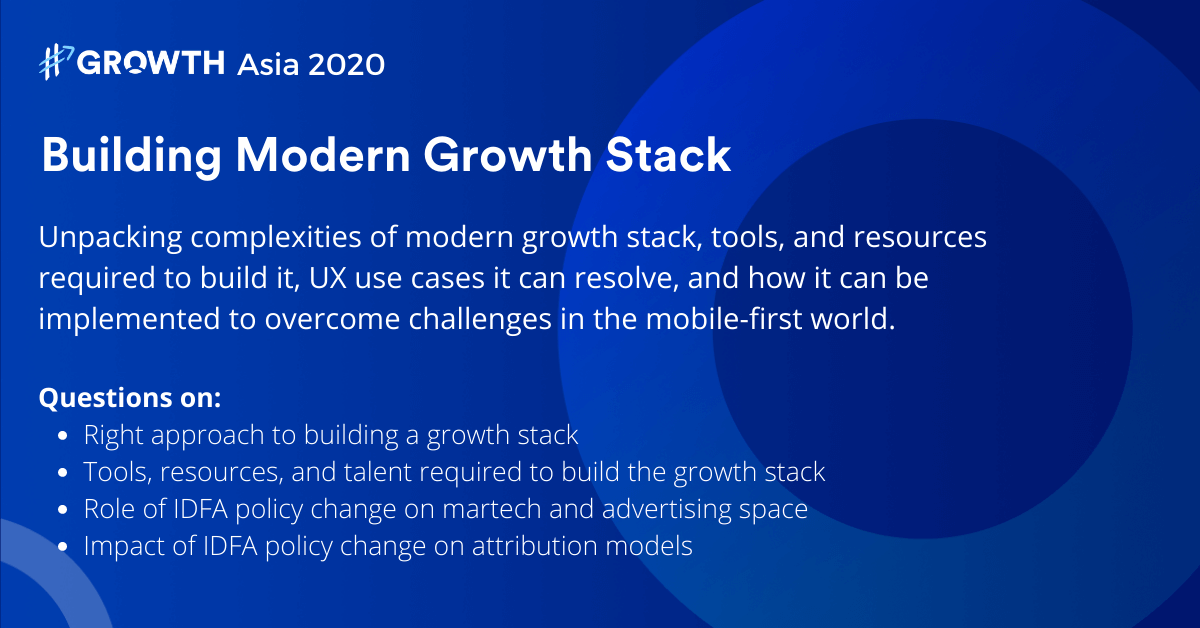
Experts:
- Ben Glynn, Head of Growth, APAC, Mixpanel
- Govind Kavaturi, Director of Partnerships, Branch
- Sherry Chao, Solutions Engineering, APAC, Segment
- Ben Desailly, Senior Martech Advisor, The Lumery
- For an SME with limited budget and resources, what should be the right stepwise approach to developing a martech stack?
Analytics tool to gather insights about your app or website. Start with Google Analytics (for page views and traffic sources) and then graduate to an advanced solution that helps you better understand individual buyer behavior and create funnel reports viz. Mixpanel.
Marketing automation tools for communicating with customers as emails are the most efficient channel for driving conversions. Also, focus on push notifications and SMS. Post considerations about Analytics and marketing automation, assess budget and invest in ad platforms viz. Facebook or Google to acquire new users or getting new eyeballs to your product.
The toughest part is to figure out the exact tools you require and finding engineering resources to implement them. Tools like Segment can help you solve this problem by virtue of being a super API, that enables you to integrate tools across all categories using their platform rather than implementing them separately.
If you are on a limited budget, prioritize customer experience and journey i.e. ideal first experience that will drive repeat behavior which can be repeat buyers or users visiting your platform time and again. Then analyze the tech and tools that can help you deliver the CX you desire to offer. - The industry is evolving now that iOS14 has announced changes about making IDFA obsolete, increasing privacy regulations, not allowing 3rd party SDKs in certain categories of apps, etc. These are indicators of how the industry is moving towards increased privacy in the coming 5-10 years.
With talks of the latest iOS version making IDFA opt-in for the users optional, it will definitely impact the advertising space and in turn martech ecosystem. In the absence of a universal identifier like IDFA, tools will not be able to accurately attribute users to exact sources that will in turn affect the understanding of channel efficiency and impact personalized experience provided by vendors. While companies can still opt for fingerprinting matching attribution, it is more of a probabilistic way compared to IDFA’s deterministic approach. The problem however with a probabilistic attribution model is the relevance of ads, i.e. due to lack of exact attribution, you might end up seeing an ad for a Samsung product when you were browsing for an Apple product. - What does it mean for the martech and advertising space and what does the future in attribution look like?
Fortunately, Apple has devised a parallel attribution system that gives an aggregate level of data but without any deeper insight which might be of importance to the advertiser. Tools like Branch which has its own persona graphing, which provides predictive matching with better attribution and thus better targeting (retargeting, re-engagement, personalization) with an accuracy of about 85% compared to a universal identifier like IDFA (which would offer 100%).Here’s What You Can Read Next













